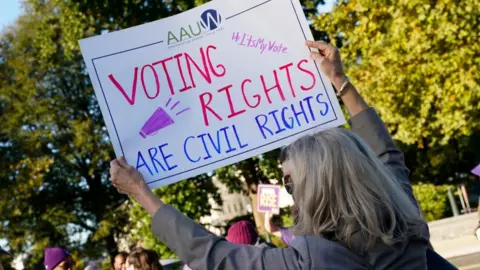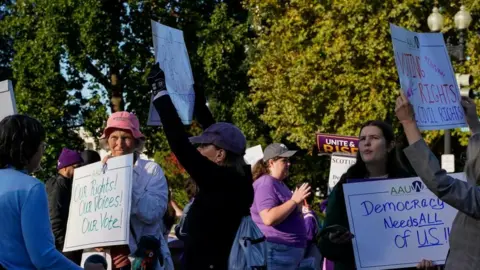Supreme Court weighs ‘earthquake’ ruling that could reshape political map

The Supreme Court heard oral arguments on Wednesday in a case that could dramatically reshape the electoral politics of the American south.
The court heard a challenge to a central pillar of the Voting Rights Act, which was originally designed to protect the electoral power of black Americans in the face of state-sanctioned discrimination.
Although the session was scheduled for only an hour, it stretched for more than twice as long, with the nine justices peppering lawyers in the case with questions.
Once the legal dust had settled, it appeared possible that a majority of the court was open to a substantial reinterpretation of the landmark civil rights era law.
If the challenge is successful, it could lead to the redrawing of congressional districts across the south that, by some estimates, could flip more than a dozen seats from Democratic to Republican.
Given the current narrow partisan divide in the US House of Representatives, such a ruling has the potential to give President Donald Trump’s party a decisive advantage in retaining their majority in next year’s midterm congressional elections.
According to UCLA law Professor Rick Hansen, it would reverse decades of court precedent and amount to an “earthquake in the American political system”.
 EPA
EPAThe case in question arises from relatively modest beginnings – a lawsuit by black voters in Louisiana seeking to force the state to draw a second majority black congressional district. They argue this would more accurately reflect the state’s demographic composition.
Section 2 of the Voting Rights Act of 1965 prohibits states from denying or limiting voting rights on the basis of race, skin colour or preferred language.
Over the decades since that law’s passage, the Supreme Court has interpreted this provision to require that states create “opportunity districts” that allow sizable minority populations to elect legislators in a proportion roughly equal to their share of the state’s population.
Approximately 31% of Louisiana’s population is black, but only one of the state’s six congressional districts has a black majority.
The US Supreme Court initially agreed to consider whether Louisiana’s electoral map complied with the Voting Rights Act – the kind of case it has regularly reviewed in the past. Two years ago, for instance, the court approved a second majority-minority district in Alabama, which subsequently elected a new black Democrat to Congress.
Over the summer, however, the conservative majority on the court changed tack, announcing that it would use the Louisiana case to consider whether Section 2 of the Voting Rights Act violated the US constitution by mandating that states take race into account when drawing congressional districts.
As if to underline the tectonic shift such a move would represent, Louisiana’s Republican officials flipped from defending their state’s legislative map, which they had said was drawn to be in compliance with the Voting Rights Act, to asking the court to do away with the law’s black-district requirements entirely.
And the Trump administration joined the case to make a similar request.
During oral arguments, Janai Nelson, who represents the original group of black Louisiana voters, warned that abandoning Voting Rights Act protections would be “pretty catastrophic”.
“We only have the diversity we see across the south because of litigation that forced the creation of opportunity districts under the Voting Rights Act,” she said.
“It is an intervention that has been crucial to diversifying leadership and providing an ability of minority voters to have an equal opportunity to participate in the process.”
 Reuters
ReutersLouisiana’s Solicitor General, J Benjamin Aguiñaga, countered that this was “sky is falling” rhetoric, and states would be reluctant to dramatically alter their congressional maps unless they put entrenched incumbents in more competitive districts.
More fundamentally, however, he argued that explicitly considering race when drawing legislative lines was unacceptable discrimination.
“The constitution does not tolerate this system of government-mandated racial balancing,” he said.
In doing so, he employed the kind of legal reasoning that the Supreme Court’s conservative majority relied on to strike down Harvard University’s race-conscious admissions policies in a major education case two years ago.
“Section 2 is the last remaining major provision of the Voting Rights Act, and it is in tension with the court’s colourblind jurisprudence,” Guy-Uriel Charles, a professor at Harvard Law School, told the BBC.
‘They are siding with the state’
While the Supreme Court is not expected to issue its decision in this case for months, Wednesday’s oral arguments indicated there may be a majority on the court who favour discarding, or at least substantially paring back, the current Voting Rights Act requirements.
Justice Brett Kavanaugh, considered one of the court’s swing votes, repeatedly expressed concern about whether there were any limits on how long the law’s minority-district requirements might stay in effect. In 2013, the Supreme Court’s had struck down a separate provision of the law – requiring federal approval for voting procedure changes – as no longer necessary.
Chief Justice John Roberts authored that ruling – and he is also seen as a potentially decisive vote in this case.
“The oral arguments are basically what we expected,” Prof Charles said. “The strong evidence from the argument is that they are siding with the state of Louisiana.”
Justices Clarence Thomas, Samuel Alito and Neil Gorsuch are also viewed as likely votes against the current interpretation of the voting law – and they said little on Wednesday to indicate otherwise.
Six years ago, a narrow Supreme Court majority ruled that states can take political affiliation into account when drawing congressional districts – a move that has opened the door for states controlled by both Democrats and Republicans to craft sometimes contorted districts that maximise their partisan advantage.
A spate of such “redistricting”, as it’s called, has played out recently, as conservative Texas has redrawn its congressional districts to maximise Republican advantage while Democratic California has sought to do likewise in response.
Conservative efforts at line drawing has often conflicted with Voting Rights Act provisions, however, as black voters traditionally voted Democratic by substantial margins – leading courts to rule that some of their districts infringe on black representation.
This amounts to “reverse partisan gerrymandering”, the Trump administration lawyer said on Wednesday – a level of protection for black Democratic voters in the south that isn’t afforded to white Democrats in states like West Virginia even though the political outcome was the same.
For decades, the US Supreme Court has disagreed. But if Louisiana has its way and the court issues its decision relatively quickly, the rush to redraw congressional lines – and cement a House of Representatives majority – may just be beginning.